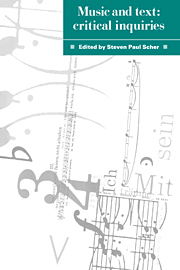Book contents
- Frontmatter
- Contents
- List of figures
- List of contributors
- Preface
- Acknowledgments
- Part I Institutional dimensions and the contexts of listening
- Part II Literary models for musical understanding: music, lyric, narrative, and metaphor
- 4 Lyrical modes
- 5 Origins of modernism: musical structures and narrative forms
- 6 Metaphorical modes in nineteenth-century music criticism: image, narrative, and idea
- 7 Narrative archetypes and Mahler's Ninth Symphony
- Part III Representation, analysis, and semiotics
- Part IV Gender and convention
- Index
7 - Narrative archetypes and Mahler's Ninth Symphony
Published online by Cambridge University Press: 04 September 2009
- Frontmatter
- Contents
- List of figures
- List of contributors
- Preface
- Acknowledgments
- Part I Institutional dimensions and the contexts of listening
- Part II Literary models for musical understanding: music, lyric, narrative, and metaphor
- 4 Lyrical modes
- 5 Origins of modernism: musical structures and narrative forms
- 6 Metaphorical modes in nineteenth-century music criticism: image, narrative, and idea
- 7 Narrative archetypes and Mahler's Ninth Symphony
- Part III Representation, analysis, and semiotics
- Part IV Gender and convention
- Index
Summary
Adorno, in the chapter titled “Roman” from his book on Mahler, at once justifies and qualifies his assertion that Mahler's music is narrative by saying that it is “not that music wants to recount something, but that the composer wants to make something in the same way that one tells a story”. He goes on to explain: at the basis of what he calls the musical novel lies a certain kind of formal freedom – freedom of the succession of events in a functional sense. He speaks of “an idiosyncrasy that must have been felt long before Mahler, who was, however, the first not to suppress it. This idiosyncrasy hates to know in advance how the music is going to continue. Such an ‘I know already’ insults musical intelligence, spiritual nervosity, Mahlerian impatience.” In Adorno's view, this loosening of control “from the outside” by a loosening of standard formal schemata or successions is one of the primary elements giving Mahler's music its narrative character. Various recent theorists of narrative would agree, at least in the point of distinction. Todorov's opposition between ritual logic and narrative logic uses the same distinction. Paul Ricoeur would say that such freedom of succession makes the listener engage in what Ricoeur calls the “narrative activity” by forcing the listener to interpret at every moment where he/she is in what kind of a paradigmatic series of events – forcing the listener to elicit, if only temporarily, a coherent configuration from a mere series of events. Clearly this does not mean complete freedom from formal paradigms.
- Type
- Chapter
- Information
- Music and TextCritical Inquiries, pp. 118 - 136Publisher: Cambridge University PressPrint publication year: 1992
- 14
- Cited by

